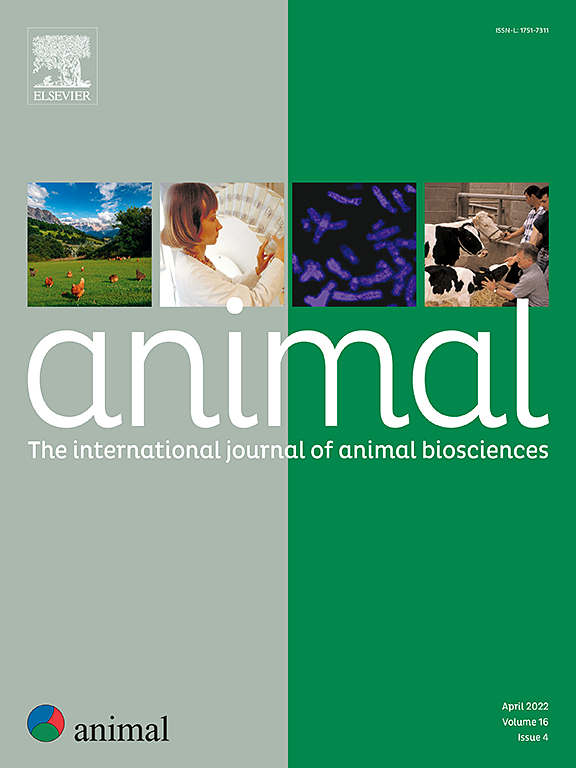Review: Multiobject tracking in livestock − from farm animal management to state-of-the-art methods
IF 4
2区 农林科学
Q1 AGRICULTURE, DAIRY & ANIMAL SCIENCE
引用次数: 0
Abstract
Multi-object tracking (MOT) methods have the potential to significantly improve precision livestock farming (PLF) by enabling simultaneous tracking of multiple animals in complex environments. However, research on MOT applications in livestock monitoring is limited, with state-of-the-art (SOTA) models primarily tested on benchmark datasets of pedestrians or vehicles. This systematic review was performed according to PRISMA guidelines. We identified 111 recent papers published from January 2019 to January 2025 using a keyword search for MOT and livestock from three scientific databases. The use-cases, datasets, and algorithms of MOT applied to livestock were thoroughly examined. This review addresses the limitations in existing systems to consistently preserve individual animal identities in long sequences. Key challenges that need to be addressed include frequent occlusions and complex, non-linear motion patterns that are characteristic of livestock behaviour. We identified 21 recent open-source SOTA models currently used in other disciplines (beyond livestock) that offer solutions to these challenges. Our analysis revealed research gaps and opportunities for developing tailored MOT techniques to overcome the challenges of real-world livestock monitoring. For MOT to provide valuable data for PLF purposes, it must perform long−term video analysis and address obstacles such as frequent and long-term occlusion, similar appearances between livestock as well as their non-linear motion. Investigating SOTA models showed that while tracking-by-detection is still the most widely used paradigm, tracking-by-attention, transformer−based end-to-end tracking architecture, provides a novel approach. Improvements in detection association strategies and motion models, as well as innovations in multi-camera tracking, can lead to improved animal health, productivity, and welfare in the livestock industry. This review highlights the importance of adapting and refining MOT methods for livestock monitoring.
综述:家畜多目标跟踪-从农场动物管理到最先进的方法
多目标跟踪(MOT)方法通过在复杂环境中同时跟踪多个动物,有可能显著提高精确畜牧业(PLF)。然而,MOT在牲畜监测中的应用研究有限,最先进的(SOTA)模型主要在行人或车辆的基准数据集上进行测试。本系统评价按照PRISMA指南进行。通过对三个科学数据库中MOT和livestock的关键词搜索,我们确定了2019年1月至2025年1月期间发表的111篇近期论文。对应用于家畜的MOT用例、数据集和算法进行了全面的研究。本综述解决了现有系统在长序列中一致保存单个动物身份的局限性。需要解决的主要挑战包括频繁的闭塞和复杂的非线性运动模式,这些都是牲畜行为的特征。我们确定了21个最近用于其他学科(牲畜以外)的开源SOTA模型,它们为这些挑战提供了解决方案。我们的分析揭示了研究差距和机遇,可以开发量身定制的MOT技术,以克服现实世界牲畜监测的挑战。为了为PLF目的提供有价值的数据,MOT必须进行长期视频分析,并解决诸如频繁和长期遮挡、牲畜之间的相似外观以及它们的非线性运动等障碍。通过对SOTA模型的研究表明,虽然基于检测的跟踪仍然是最广泛使用的范式,但基于变压器的端到端跟踪体系结构提供了一种新颖的方法。检测关联策略和运动模型的改进,以及多摄像机跟踪的创新,可以改善畜牧业的动物健康、生产力和福利。这篇综述强调了调整和改进MOT方法用于牲畜监测的重要性。
本文章由计算机程序翻译,如有差异,请以英文原文为准。
求助全文
约1分钟内获得全文
求助全文
来源期刊

Animal
农林科学-奶制品与动物科学
CiteScore
7.50
自引率
2.80%
发文量
246
审稿时长
3 months
期刊介绍:
Editorial board
animal attracts the best research in animal biology and animal systems from across the spectrum of the agricultural, biomedical, and environmental sciences. It is the central element in an exciting collaboration between the British Society of Animal Science (BSAS), Institut National de la Recherche Agronomique (INRA) and the European Federation of Animal Science (EAAP) and represents a merging of three scientific journals: Animal Science; Animal Research; Reproduction, Nutrition, Development. animal publishes original cutting-edge research, ''hot'' topics and horizon-scanning reviews on animal-related aspects of the life sciences at the molecular, cellular, organ, whole animal and production system levels. The main subject areas include: breeding and genetics; nutrition; physiology and functional biology of systems; behaviour, health and welfare; farming systems, environmental impact and climate change; product quality, human health and well-being. Animal models and papers dealing with the integration of research between these topics and their impact on the environment and people are particularly welcome.
 求助内容:
求助内容: 应助结果提醒方式:
应助结果提醒方式:


